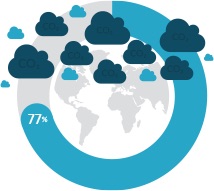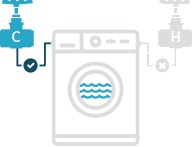
Carbon dioxide (CO2) accounts for up to 77% of polluting greenhouse gas emissions. Cut your emissions and save.
With just a small amount of effort, you can help make a lasting impact on the environment, reverse the trends of climate change and cut your cost with Texas electric companies. And you’ll save money on your Texas electricity rate and usage at the same time!

How to cut your carbon and save money
If you can’t switch to a 100% green energy plan for your home, there are many ways to reduce your home’s electricity usage to cut CO2, from switching to LED light bulbs to installing energy efficient appliances. You can monitor your electricity usage at Smart Meter Texas.
Your heating and air conditioning system is the biggest single factor in your monthly electric bill, and using a smart thermostat can give you instant electricity savings. And did you know that installing proper insulation in your attic can be your best bang for the buck?
Now check out our list of energy-saving tips and start sharing in the effort to safeguard the Earth by reducing your carbon footprint with these simple ideas that will also cut your costs. You’ll find suppliers of energy-saving devices, insulation, windows in our Houston, Dallas and Top Texas Cities page. And check our Best Texas Electricity Rate Chart for the best rates from top name brand energy providers.
Use Renewable Energy to Power Your Home

Over 30% of energy-related CO2 in the U.S. is associated with electricity.
First, consider this: If you live in a deregulated energy state where consumers have the power to choose their energy providers, select a 100% renewable energy plan to immediately zap your home’s fossil footprint
Check our home page for low-cost green plans from electricity providers like Pulse Power, Gexa Energy and others. These plans will have lower electricity rates than most polluting fossil-fuel-sourced energy plans. Enroll in less than 10 minutes.

By converting to a green energy plan, a small or mid-size home that burns an average of about 1000 kWh of energy per month will annually cut about 1,300 pounds of CO2, equivalent to the amount of CO2 absorbed annually by 1,800 young trees.

If you live in a regulated energy state that provides home solar panel subsidies, government incentives can offset the cost of solar energy equipment.

In addition, there are federal home solar subsidies available.
Improve Attic Insulation

The Dept. of Energy estimates that a properly insulated attic can reduce your electricity consumption and give you savings of 10 to 50% off your monthly bill.
Although commonly used fiberglass has a lower upfront cost and is easy to apply and replace, this type of insulation can hide air leaks and is less efficient.
Green home builders recommend that blown-in cellulose insulation has a better R-Value rating of 3.2-3.9, which gives it much better insulation quality.
Use Appliances Certified by Energy Star Program

Purchase Energy Star Products which are certified to be more efficient, reducing your energy consumption between 10 to 50% each year. Major appliances to upgrade include refrigerators, water heaters, washers and dryers.
Energy Star is a program of the U.S. Department of Energy (DOE).

Water heaters are one of the most energy-consuming appliances. When you buy a new water heater, make sure it has an Energy Star rating with an R-Value of at least 24.

This can give you an annual energy savings of at least 16%.
Get a Smart Thermostat

A smart thermostat
will learn your preferences and suggest settings to conserve energy, reducing your home heating and cooling energy use up to 15%.
Buy LED Lightbulbs

Although LEDs have a higher upfront cost, the cost is offset by having a much longer lifetime.

They will reduce your CO2 and save you money by using 1/3rd to 1/30th of the energy of incandescent light bulbs.
Turn Off Lights

Lighting usage accounts for around 11% of your home’s electricity.

Installing smart light switches on existing light fixtures can save electricity by turning lights off when you are not using rooms, and have added benefits like dimming or remote usage.
Unplug Your Devices

Many electronics will consume electricity when plugged in, even when not in use.
Stand-by energy can be lessened by using an advance or smart power strip.
By simply unplugging or flicking the “off” button on a power strip, you can save on your energy costs and help reduce your individual carbon footprint by 20% or more.
Place Exterior Shading Around Your House

Carefully positioned trees can reduce a household’s energy consumption for heating and cooling by up to 25%.

The Dept. of Energy estimates that the proper placement of just three trees can save an average household between $100 and $250 in energy costs.

Shading of an air conditioner can increase its efficiency by as much as 10%.

Improve energy efficiency by using cost-effective “Low-e” window film on existing windows and enjoy an energy savings of around 15-20%.

Keeping your windows and doors sealed to cut down on drafts gives you an advantage of around 10 to 20% energy reduction and savings.
Wash in Cold

You can eliminate 90% of a typical washing machine’s electricity usage by washing with cold water. 
Get a Low-Flow Showerhead

If every household in the U.S. installed one of these, the country could reduce annual water consumption by 250 billion gallons, conserving the energy required to process and bring clean water to your tap.

These shower heads use two gallons per minute or less vs the 2.5 gallons per minute from a standard showerhead.

CAUTION: DOUBLE PANE WINDOWS ARE PAINFUL FOR YOUR POCKETBOOK
According to the Energy Star program, the average home can gain up to $465 in energy savings per year by replacing single-pane windows with double-pane windows.
However, because the cost of replacing windows may run tens of thousands of dollars for many homes, it can often take decades to recoup your investment.
ESTIMATED AVERAGE ENERGY CONSERVED AND SAVINGS PER YEAR
Energy Saving Tip Average Energy Reduction and Savings
| Energy Star Appliances | 10-50% |
| Energy Star Water Heater | 16% |
| Smart Thermostat | 15% |
| Attic Insulation | 10-50% |
| LED Lightbulbs | 30% |
| Turn Off Lights | 10% |
| Unplug Your Devices | 20% |
| Exterior Shading Around Your House | 25% |
| Wash in Cold | 90% |

Most people already know that lowering your energy usage is one of the most powerful ways to reduce your carbon footprint and save money, but many people don’t know exactly which items to focus on in order to get immediate, high-impact results. We hope you’ve found our information helpful in doing just that.
Whether you use advanced options like purchasing a smart home system to manage your usage, or low-tech solutions like keeping curtains closed during hot weather, you can take action right now to cut your usage and help safeguard the planet.

